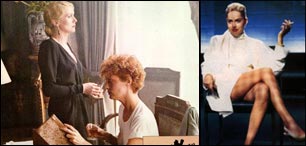|
Thus, paradoxically, Lynch employs
camp and cruel Hollywood iconography to humanise the tragedy
of the actress. Nostalgia, pastiche and the play of references
enhance his tragic portrait of Hollywood. Lynch’s focus on
unceasing role play, artificiality and self-invention underscore
his understanding of the power of Hollywood as constituting
the most seductive form of ideology. Equally, grotesque, mythic
and surreal imagery humanise the actress’s career. Can we
therefore say that Mulholland Drive’s depiction of
marvellous femininity is an unambiguous portrait of the masculine
imagination ? Is his portrait of female desire a product
of the masculine imagination too ? Lynch’s portrayal
of lesbian desire is also dark and ambiguous while it is invested
with sensuality and humanity. It is particularly to love and
eroticism that I now turn.
Transgressive Modern and Surreal
Modern Love and Female Homosexual Desire
| |
 |
|
|
The portrayal of lesbian love in popular
culture has become conventional although female homosexual
love denotes a unique eroticism. The ubiquity of lesbian love
in soft pornography and the eroticised imagery of female homosexual
figures in blockbusters such as Basic Instinct (1991)
vision testifies to its fashionability. Ignited perhaps by
Madonna’s amused, post-modern role-playing in the nineties,
lesbianism has enjoyed a chic status in the popular and masculine
imagination. This has undoubtedly been denied to the male
homosexual in mainstream culture. Manifestly, the vision of
two beautiful women making love only intensifies male pleasure.
Although her love is homosexual, the figure of the lesbian
serves male heterosexuality. It is a stolen figure which is
also corrupted. Popular culture depicts the lesbian as erotically
extreme and violent. An icon of modern cinema, a certain Catherine
Trammel in Basic Instinct has famously illustrated
this popular bind between lesbianism and violence. Catherine,
played by Sharon Stone in her breakthrough role, is a glacial
but golden figure who beds both men and women. She is the
principal suspect in a murder investigation. In Mulholland
Drive, David Lynch alludes to the popular, cinematic stereotype
of the homicidal lesbian. As we have seen, Diane is sexually
aggressive. Following her rejection by Camilla, she forces
her movie-star lover to have sex with her. Further to her
rejection, Diane masturbates violently in teary despair, literally
abuses her sex. As we have also noted, Diane ultimately arranges
the murder of her lover. However, as argued above in relation
to his depiction of the homicidal femme fatale, Lynch’s
portrayal, I suggest, ultimately critiques the popular and
psychoanalytical misogynous image of the homicidal lesbian
as exhibited in Basic Instinct. David Lynch’s version
of lesbian love is more complex and ambiguous. It is more
romantic and poetic.
In the poetic imagination, lesbianism has
been savoured for its absolute romantic character and its
extraordinary sensuality. Baudelaire tenderly describes Lesbos
a “terre des nuits chaudes et langoureuses” (8) [“land
of hot and languorous nights”]. In this strange but sensual
land, the kisses of the lover are both “languissant et
joyeux”[“full of longing and joy”] (9). Such love
expresses a unique emotional potency :
“Lesbos, où les baisers sont comme les cascades
Qui se jettent sans peur dans les gouffres sans fonds
Et courent, sanglotant et gloussant par saccades,
Orageux et secrets, fourmillants et profonds ;
Lesbos, où les baisers sont somme les cascades”
[“Lesbos, where the kisses are like cascades
Which fearlessly flow into the bottomless abyss
And run, weeping and clucking by cascades
Stormy and secret, swarming and deep
Lesbos, where the kisses are like cascades”] (10)
|